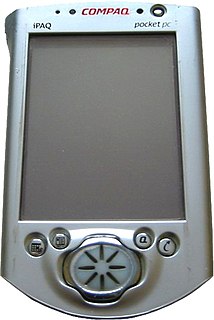
A Pocket PC is a class of personal digital assistant (PDA) that runs the Windows Mobile or Windows Embedded Compact operating system that has some of the abilities of modern desktop PCs. The name was introduced by Microsoft in 2000 as a rebranding of the Palm-size PC category. Some of these devices also had integrated phone and data capabilities, which were called Pocket PC Phone Edition or simply "Smartphone".
The O2 Xda brand was a range of Windows Mobile PDA phones, marketed by O2, developed by O2 Asia and manufactured by multiple OEMs (mainly HTC, Quanta and Arima). The first model was released in June 2002. The last models came to market in 2008. The "X" represents convergence of voice and information/data within one product; the "DA" stands for "Digital Assistant", as in PDA. The name of XDA Developers is derived from it.
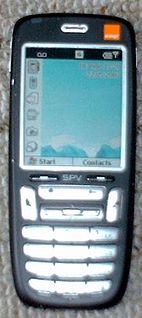
The HTC Typhoon is a smartphone that runs the Microsoft Windows Mobile operating system. The phone is manufactured by Taiwanese HTC Corporation (HTC). At the time when the Typhoon was made, HTC was not in the business of selling devices to end-users. Instead, the company had many partners who would rebrand and distribute its devices.
The HTC Touch family is a family of Pocket PCs designed and manufactured by HTC Corporation. This family is in the process of being built up, and its slogan is Discover Touchnology.
The HTC Touch HD, also known as the HTC T828X or its codename the HTC Blackstone, is a Windows Mobile 6.1 Pocket PC designed and manufactured by HTC launched in 2008.
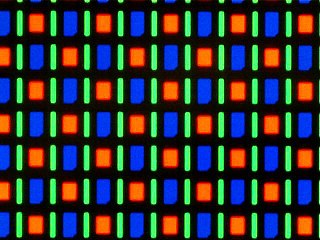
AMOLED is a type of OLED display device technology. OLED describes a specific type of thin-film-display technology in which organic compounds form the electroluminescent material, and active matrix refers to the technology behind the addressing of pixels.
The HTC Touch Diamond2, a mobile phone designed by the HTC Corporation, is the successor to the popular HTC Touch Diamond. It is also known by its codename, the HTC Topaz. It is released with Microsoft Windows Mobile 6.1, but can be upgraded to Windows Mobile 6.5. It is the first device to feature a revamped version of HTC's TouchFLO 3D GUI, an interface first seen on its predecessor. The Touch Diamond2 has been announced to be released in Q2 2009 and was first announced at the Mobile World Congress 2009 in Barcelona.

Samsung GT-i8910 Omnia HD is a smartphone manufactured by Samsung Electronics, first announced at MWC 2009 on February 18, 2009. The device was the first phone capable of playing and recording 720p HD video. It runs on the S60 5th Edition (Symbian^1) platform, the only Samsung device to do so.

Windows Mobile 6.5 is a stopgap update to Windows Mobile 6.1 intended to bridge the gap between version 6.1, that arrived in 2008, and the then yet-to-be-released Windows Phone 7.
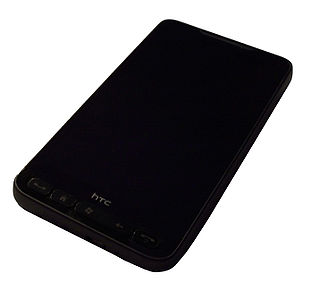
The HTC HD2, is a smartphone in the HTC Touch family designed and manufactured by HTC. The HD2 natively runs the Windows Mobile 6.5 operating system, and was released in Europe in November 2009, in Hong Kong in December 2009, and in other regions including North America in March 2010. The phone is the successor to the HTC Touch HD, and is succeeded by the HTC HD7.

The HTC Desire is the first smartphone of the Desire series developed by HTC. It was announced on 16 February 2010 and released in Europe and Australia in the second quarter of the same year. The HTC Desire was HTC's third flagship phone running Android 2.1 Eclair which can be upgraded to 2.2 Froyo or 2.3 Gingerbread. Internally it bears a strong resemblance to the Nexus One, but differs in some features.

The HTC Evo 4G is a smartphone developed by HTC Corporation and marketed as Sprint's flagship Android smartphone, running on its WiMAX network. The smartphone launched on June 4, 2010 and was the first 4G enabled smartphone released in the United States.

The HTC 7 Surround is a smartphone created by HTC running on the Windows Phone 7 operating system. The HTC Surround launched on November 8, 2010 on AT&T.

The Acer Iconia is a range of tablet computers from Acer Inc. of Taiwan.
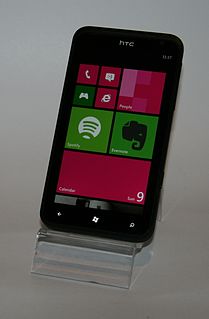
The HTC Titan, is a smartphone running the Windows Phone OS 7.5 operating system. The phone was designed and manufactured by HTC Corporation. It is the successor to the HTC HD7.

Samsung Galaxy W (i8150), also known as Samsung Wonder, is an Android smartphone that is a smaller-sized variant of Samsung Galaxy S II.

The Samsung ATIV S is a touchscreen, slate smartphone manufactured by Samsung Electronics running the Windows Phone 8 operating system, upgradeable to Windows Phone 8.1. The ATIV S is Samsung's first Windows Phone 8 device, and one of the first devices under its ATIV series of Microsoft Windows-based products. It was shown at the IFA 2012 in Berlin and was the first Windows Phone 8 device to be officially unveiled, ahead of the Nokia Lumia 920.
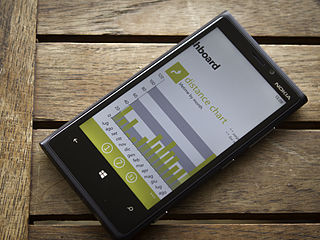
Nokia Lumia 920 is a smartphone developed by Nokia that runs the Windows Phone 8 operating system. It was announced on September 5, 2012, and was first released on November 2, 2012. It has a 1.5 GHz dual-core Qualcomm Krait CPU and a 4.5" IPS TFT LCD display, as well as a high-sensitivity capacitive touchscreen that can be used with gloves and fingernails; the display is covered by curved Gorilla Glass and has a 9 ms response time. The phone features an 8.7-megapixel PureView camera with OIS; it was the first smartphone to offer that technology, as well as to support Qi inductive charging. The phone comes with 32 GB of internal storage, but has no expandable storage.

The Nokia Lumia 1520 was a flagship Windows Phone phablet smartphone designed and produced by Finnish telecommunications manufacturer Nokia in partnership with American software manufacturer Microsoft. The device was first announced at the Nokia World event on 22 October 2013 in Abu Dhabi, alongside its mid-range phablet stablemate the Nokia Lumia 1320 and Nokia's 10.1 inch Windows RT tablet the Nokia Lumia 2520. Until its discontinuation in the United States on 7 April 2015 the phone served as the flagship device for Nokia's Lumia Series and Microsoft's mobile effort. On 6 October 2015 Microsoft officially announced its flagship phablet successor, the Microsoft Lumia 950 XL, with availability sometime in November 2015.

The HTC One (M8) is an Android or Windows smartphone manufactured and marketed by HTC. Following a number of leaks that occurred during the months prior, the device was officially unveiled in a press conference on March 25, 2014, and released the same day by Verizon Wireless at retail, and by other Canadian and United States carriers for online orders prior to its wider retail availability in mid-April.















